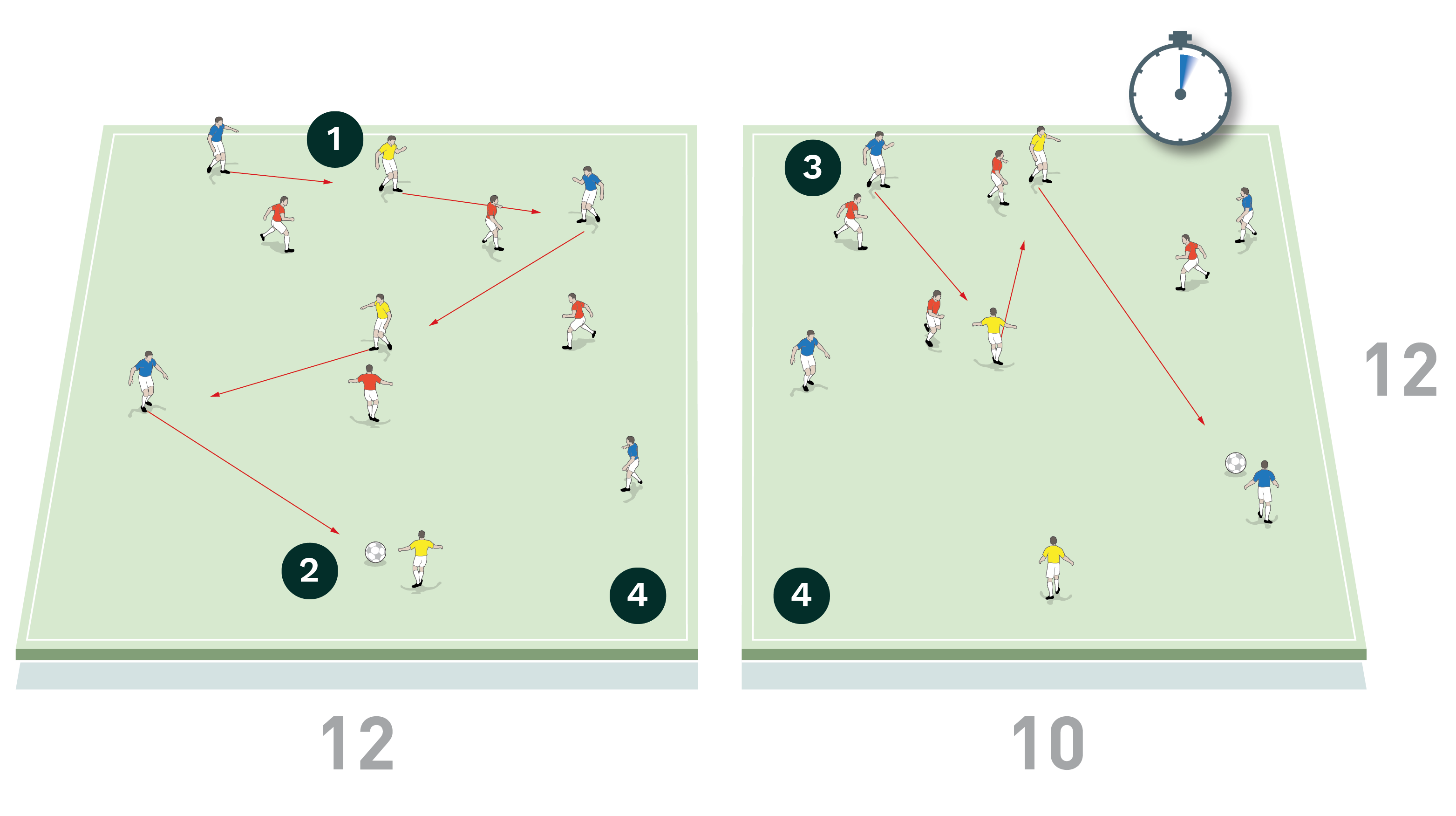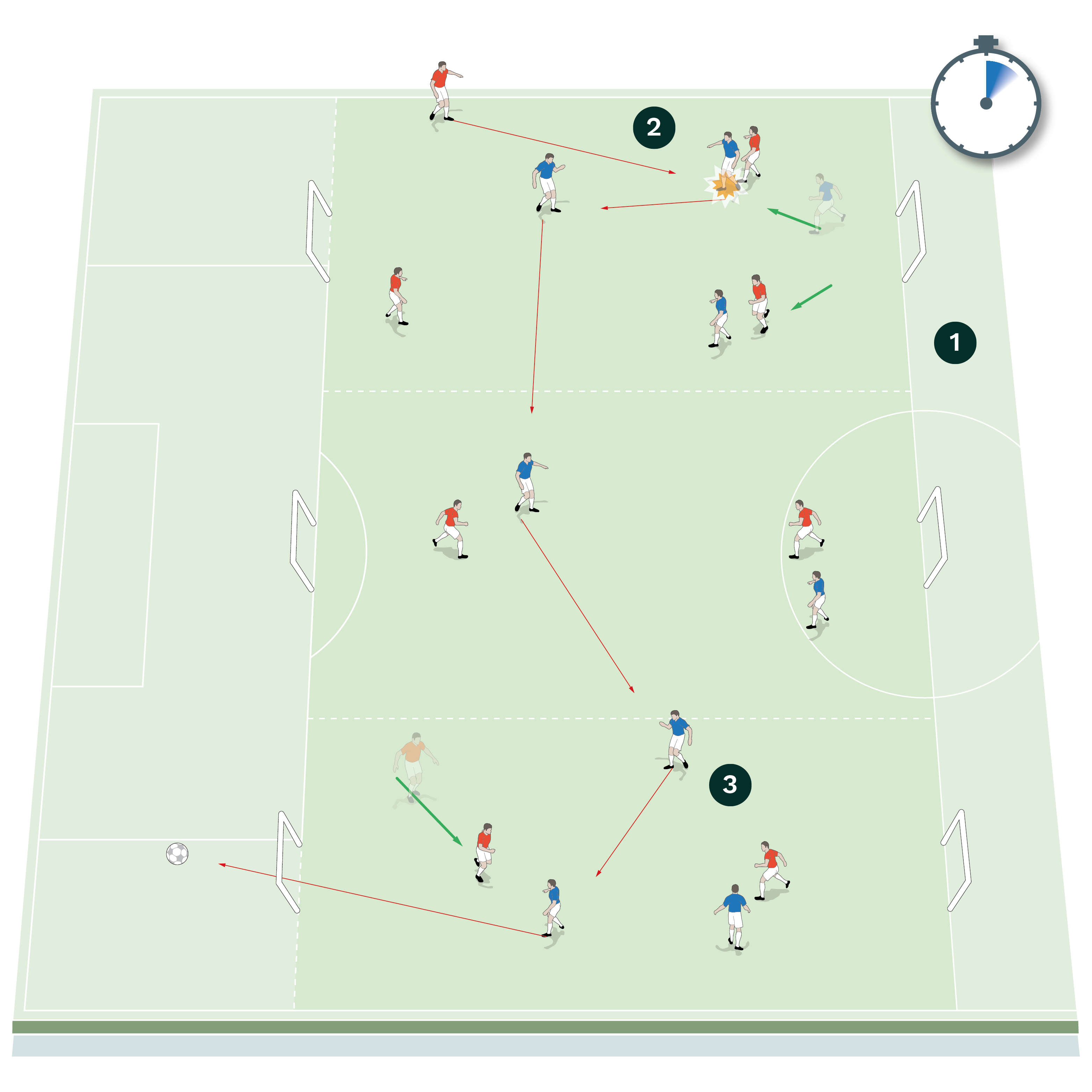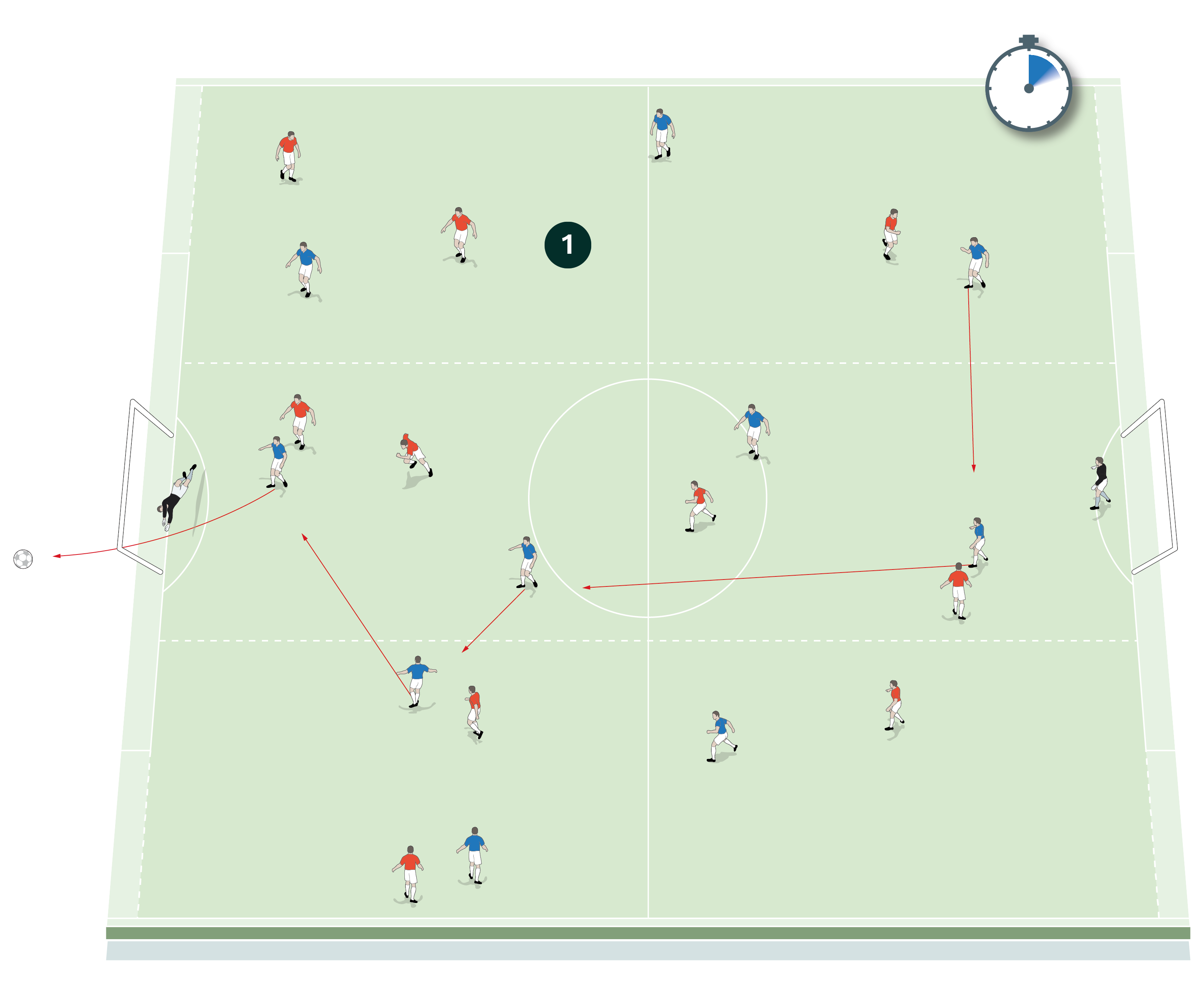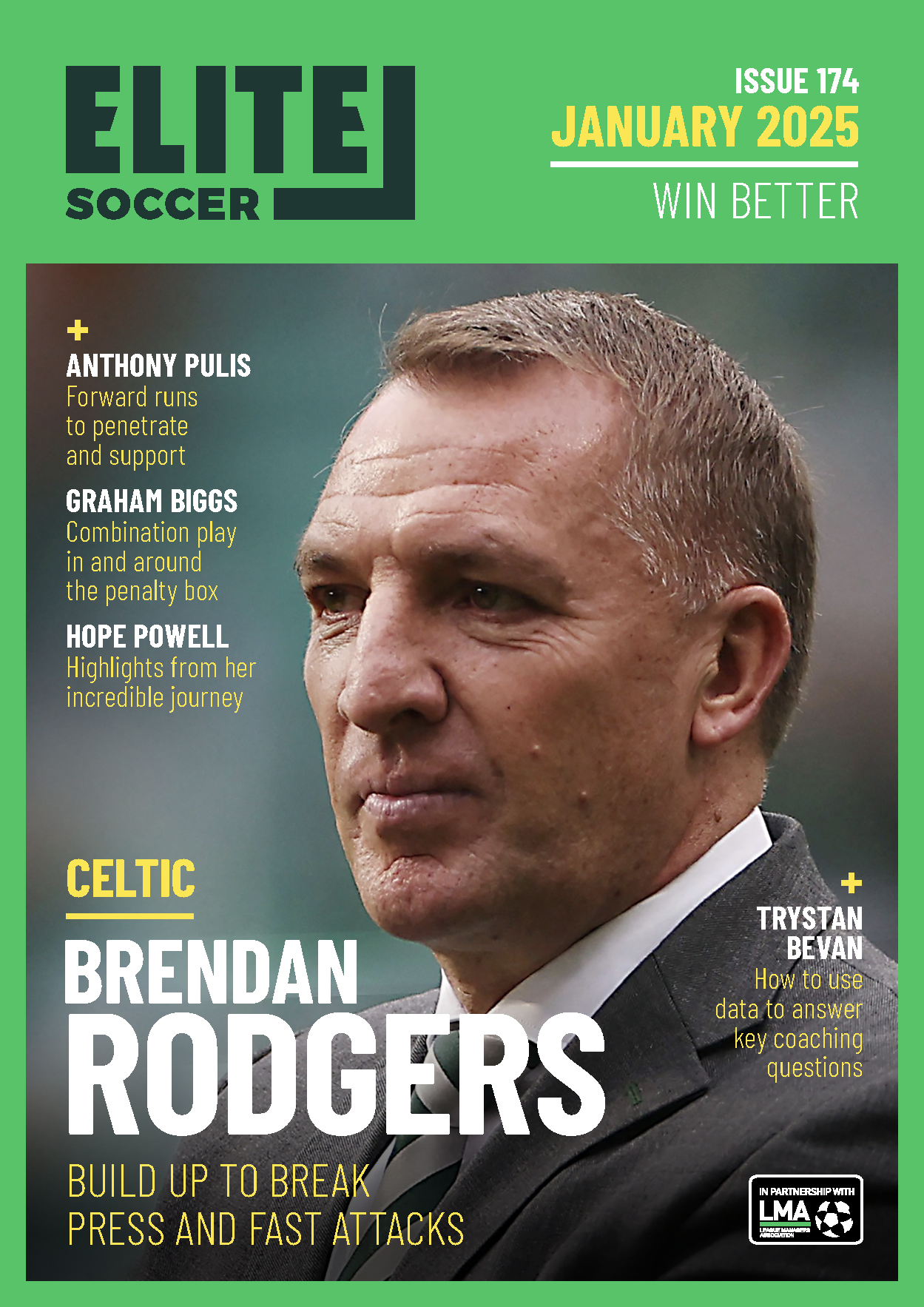You are viewing 1 of your 1 free articles
Switching play
| Area | Up to two thirds of pitch |
| Equipment | Balls, bibs, cones, 6 small goals, 2 full size goals |
| No. of Players | 20 players + 2 goalkeepers |
| Session Time | Switching grids: 12 minutes Switching zones: 18 minutes 11v11 game: 24 minutes |
In this session we focus on switching play and trying to create numerical advantages all over the pitch. The objective is to exploit the defending team and capitalise on a switch of play by creating goal scoring opportunities. This requires players to be looking to change the direction of play and then either cause an overload or simply catch the opposition off guard.
The game today is all about the finer details and even a simple 2v2 session needs to be specific to the overall outcome. We want our players to be asking questions of themselves: Can I switch the play? Do we have the numbers? Does the opposition have the time to react? Is it on?
This particular session is geared toward helping the players see when a switch can happen and recognising what it looks like, while encouraging them to take responsibility to deliver the required pass in order to create that attacking moment.
I tend to use this session in various guises – I might use the first part as a warm up, or I could use the second part before going into a phase of play, and of course the last part could be a session all on its own. Here I will use all three parts of the session, which is what I do when introducing it to the players for the first time.
“The objective is to exploit the defending team and capitalise on a switch of play by creating goal scoring opportunities”
SWITCHING GRIDS
After a general warm up [not shown], we will set up two playing grids side by side: one is 12x12 yards and the other is 12x10 yards. We’re using 22 players split into two groups, with one group of 11 players for each playing area. In each area we simultaneously play a 4v4 game with three yellow floaters playing for the team in possession, as shown [1].
In the slightly larger 12x12-yard area, the aim is for the team in possession to move the ball from one end to the other. To do this they can use the help of the three yellow floaters to keep hold of the ball. In this area we would play two three-minute games, with the players limited to two-touch for the first game and no restriction on touches for the second.
In the smaller 12x10-yard area, the aim is still for the possession team to move the ball from one end to the other with the help of the floaters but in this grid we would play a three-minute game with players limited to one- touch, followed by a three-minute game with no restriction on touches. After two games on one grid, the teams would switch to the other grid for another two games.
In this activity, we want to see quality passing into feet, good off-the-ball movement, and an awareness of where team mates are. Being able to get the ball from one end to the other whilst maintaining possession is one of the challenges, but the other important aspect is that players should react quickly when losing possession.
[1]

2. In the 12x12-yard grid, play a three-minute game with players limited to two-touch, followed by a three- minute game with players on unlimited touches
3. In the 12x10-yard grid, play a three-minute game with players limited to one-touch, followed by a three-minute game with players on unlimited touches
4. After two games on one grid, teams move across to play two games on the other grid
SWITCHING ZONES
[2]

2. Teams cannot score in the zone where they win possession. Here the blues win the ball and must switch the play to another zone before taking a shot at goal
3. Players should recognise where their team has a numerical advantage, so they know when the switch is on and where there is an opportunity to score
“We want to see quality passing into feet, good off-the-ball movement, and an awareness of where team mates are”
After having established that we are looking to switch play as quickly as possible, we move on to the next part of the session. Using the full width of a pitch, we set up between the 18-yard line and the halfway line, with three small goals positioned at each end and with the playing area divided into three zones, as shown [2].
We’re using 16 players split into two teams of eight and we play an 8v8 directional game, with the teams trying to score at the end they are attacking. The rules can vary in terms of how many touches players are allowed, but a team cannot score in the zone where they win the ball. This forces the two teams to look to switch play at all times. We want the players to be looking to see where the numerical advantage is so they can recognise when the switch is on and where there is an opportunity to score.
We would play three games of six minutes each. In one game we would limit the players to one-touch, in the second game players would be all-in, and in the third game we would limit the players to two-touch.
11v11 GAME
We set up between the penalty areas of a normal pitch that is split length-wise into three zone, with a full size goal positioned at each end. We’re using 20 outfield players and two goalkeepers, split into two teams of 11.
We play an 11v11 game and the principle objective remains to encourage teams to switch the play. To achieve this, the ball must be moved through all three zones in an attacking move before a shot on goal can be taken, as shown [3].
Again, teams cannot score in the same zone that they win possession. We would want to see players using good off-the-ball movement to create areas of the pitch where their team has a numerical advantage that can be exploited.
In this game there is no limit on touches. We would play for 12 minutes. Then we would remove the zones and play for another 12 minutes, asking players to keep the emphasis on switching play.
[3]

“We want the players to be looking to see where the numerical advantage is so they can recognise when the switch is on”
Related Files
Editor's Picks
Using the goalkeeper in build-up play
Pressing principles
Intensive boxes drill with goals
Penetrating the final third
Creating and finishing
My philosophy
Pressing initiation
Compact team movement
Defensive organisation
Coaches' Testimonials

Alan Pardew

Arsène Wenger

Brendan Rodgers

Carlos Carvalhal

José Mourinho

Jürgen Klopp

Pep Guardiola

Roy Hodgson

Sir Alex Ferguson

Steven Gerrard
Coaches' Testimonials

Gerald Kearney, Downtown Las Vegas Soccer Club

Paul Butler, Florida, USA

Rick Shields, Springboro, USA

Tony Green, Pierrefonds Titans, Quebec, Canada
Join the world's leading coaches and managers and discover for yourself one of the best kept secrets in coaching. No other training tool on the planet is written or read by the calibre of names you’ll find in Elite Soccer.
In a recent survey 92% of subscribers said Elite Soccer makes them more confident, 89% said it makes them a more effective coach and 91% said it makes them more inspired.
Get Monthly Inspiration
All the latest techniques and approaches
Since 2010 Elite Soccer has given subscribers exclusive insight into the training ground practices of the world’s best coaches. Published in partnership with the League Managers Association we have unparalleled access to the leading lights in the English leagues, as well as a host of international managers.
Elite Soccer exclusively features sessions written by the coaches themselves. There are no observed sessions and no sessions “in the style of”, just first-hand advice delivered direct to you from the coach.









